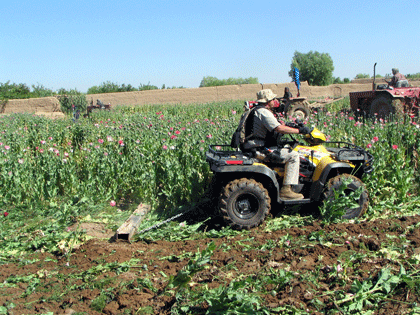only magazine
↵ home
Afghanistan: Part 3

By Sean Condon
Friday December 1, 2006
Drugs and development
When the Taliban went for cover in thick forests of 10-feet high marijuana plants, Canadian troops in Afghanistan were forced to retreat. Last October, Canadian soldiers tried to burn the plants down and smoke the Taliban out, but soldiers caught in the downwind got high and had to give up the fight. Score: Drugs 1, Canada 0.
The battle with the bud actually symbolises the problem Canada is having in trying to win the “hearts and minds” of Afghanis: drugs are beating development. As Canada and NATO continue to fail in providing aid and infrastructure, the Taliban are using the country’s abject poverty and flourishing drug trade to keep Afghanistan completely whacked out on goofballs.
“Extreme poverty is leading to growing anger and resentment against the international community and is directly fuelling the insurgency and support for the Taliban,” said Canadian-born Norine MacDonald, president and Kandahar field researcher for The Senlis Council, in a recent press release. “People feel abandoned by the Canadians and all internationals, who they believed were there to help them. Canadian troops in Kandahar are fighting the Taliban insurgency against a backdrop of an increasingly hostile local population.”
According to Senlis, the international community has spent US$82.5 million on its military campaign since the invasion, but only US$7.3 billion on redevelopment. The World Bank estimates the country needs $27.5 billion to come out of the Dark Ages. Canada’s own military contribution is expected to reach $10 billion by 2009, while development aid will only be $1 billion. The added problem with this warped balance is that, because of security problems, Canada’s aid has produced very little concrete results — except for a lot of bombs on a lot of villages.
Meanwhile, Afghanis continue to go hungry. The World Food Program says over 2 million of them will not be fed this winter because international supplies have not arrived in time.
According to UN reports, poverty is keeping tens of thousands of children in Kabul out of school, forcing them to work in the street. In the face of this devastating reality, Canada is about to cut a $2.5 million annual food-for-widows program this April and replace it with a training project, despite concerns from the Afghani women that they’ll go hungry. It cost $1.2 million to bring Tim Hortons to Afghanistan.
Without much to go on, Afghanis don’t have many options but to turn to drugs. And by all accounts they’re getting blasted. According to the United Nations, opium production has increased from 185 tonnes in 2001 to a record breaking 6,000 tonnes in 2005. The Taliban helped wipe out the drug in 2000 in order to win international favour, but are now using it to fuel their fight against NATO. These beautiful and blissful poppies make up for roughly 90 per cent of the world’s heroin, are worth $3.1 billion a year to Afghanistan’s economy (about half of the country’s GDP), employ 2.3 million people and are the main source of income for 30 per cent of the country’s households. Score: Drugs 2, Canada 0.
Despite the lack of any real economic alternatives (opium yields 10 times more than any other crop), the United States has led a fierce poppy eradication campaign and now spends $780 million a year on being a buzz kill. Senlis, which is adamantly opposed to Canada leaving Afghanistan, wants Canada to put more money into development and less into bombs, and start a “Buy Morphine Campaign” so farmers can help make 90 per cent of the world’s painkillers and not starve to death. Unfortunately, Senlis has had no luck getting Harper or any of his cabinet ministers to sit down and discuss the idea with them. Final score: Bullshit 3, Canada 0.
